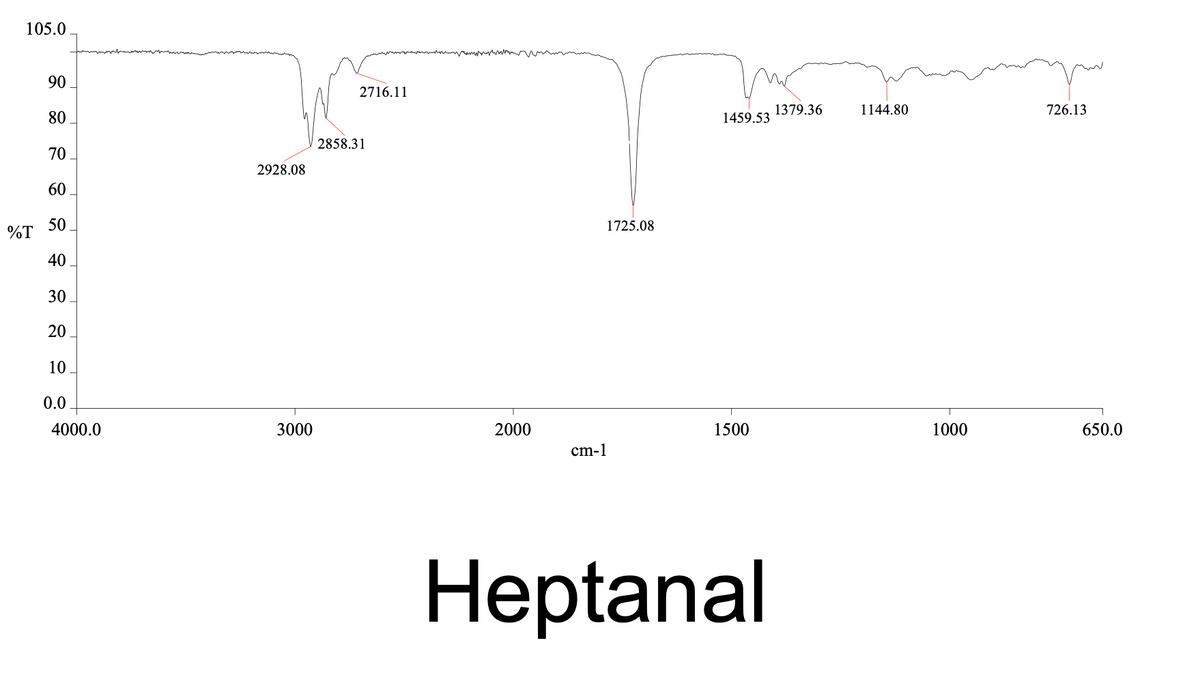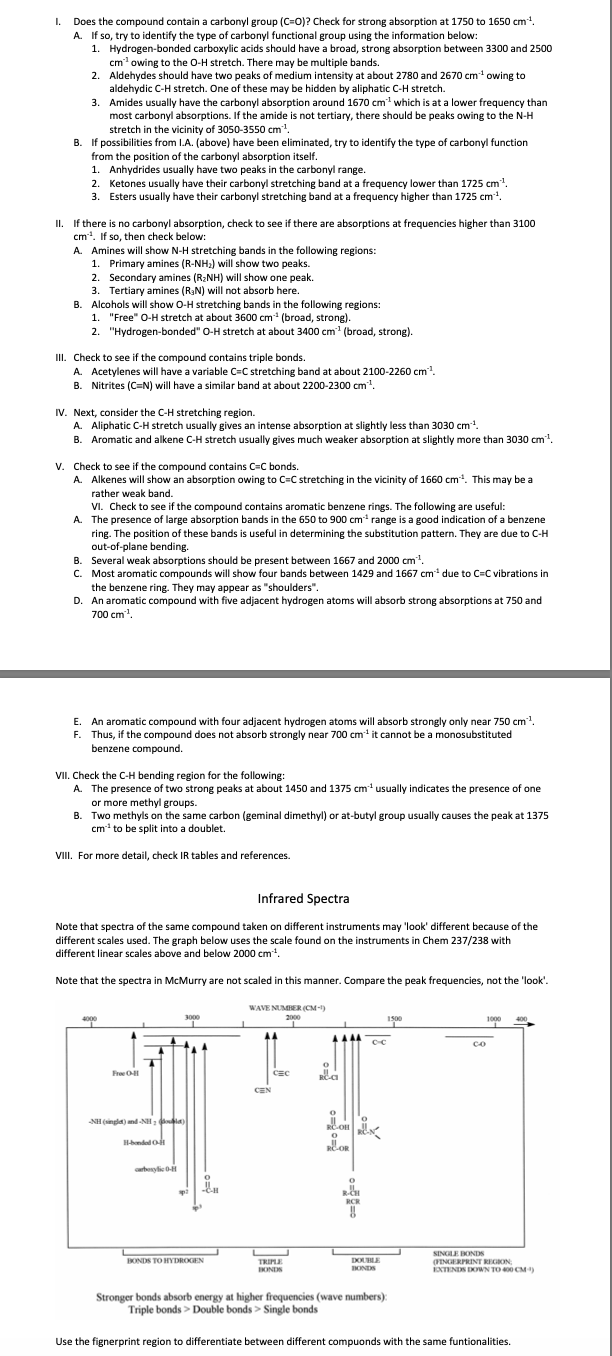Using the attached infrared spectroscopy spectrum for the compound Heptanal, identify the functional group and any observed characteristic absorbtions in cm-1. Compare with the attached roadmap for interpreting IR spectra
Using the attached infrared spectroscopy spectrum for the compound Heptanal, identify the functional group and any observed characteristic absorbtions in cm-1. Compare with the attached roadmap for interpreting IR spectra
Chemistry: Matter and Change
1st Edition
ISBN:9780078746376
Author:Dinah Zike, Laurel Dingrando, Nicholas Hainen, Cheryl Wistrom
Publisher:Dinah Zike, Laurel Dingrando, Nicholas Hainen, Cheryl Wistrom
Chapter14: Mixtures And Solutions
Section14.1: Types Of Mixtures
Problem 7SSC
Related questions
Question
100%
Using the attached infrared spectroscopy spectrum for the compound Heptanal, identify the functional group and any observed characteristic absorbtions in cm-1. Compare with the attached roadmap for interpreting IR spectra.

Transcribed Image Text:105.0
90
2716.11
1379.36
1144.80
726.13
80
1459.53
2858.31
70
2928.08
60
50
1725.08
%T
40
30
20
10
0.0
4000.0
3000
2000
1500
1000
650.0
cm-1
Нeptanal

Transcribed Image Text:Does the compound contain a carbonyl group (C=0)? Check for strong absorption at 1750 to 1650 cm.
A. If so, try to identify the type of carbonyl functional group using the information below:
I.
1. Hydrogen-bonded carboxylic acids should have a broad, strong absorption between 3300 and 2500
cm owing to the O-H stretch. There may be multiple bands.
2. Aldehydes should have two peaks of medium intensity at about 2780 and 2670 cm owing to
aldehydic C-H stretch. One of these may be hidden by aliphatic C-H stretch.
Amides usually have the carbonyl absorption around 1670 cm which is at a lower frequency than
most carbonyl absorptions. If the amide is not tertiary, there should be peaks owing to the N-H
stretch in the vicinity of 3050-3550 cm.
B. If possibilities from L.A. (above) have been eliminated, try to identify the type of carbonyl function
from the position of the carbonyl absorption itself.
1. Anhydrides usually have two peaks in the carbonyl range.
Ketones usually have their carbonyl stretching band at a frequency lower than 1725 cm.
2.
3. Esters usually have their carbonyl stretching band at a frequency higher than 1725 cm.
II. If there is no carbonyl absorption, check to see if there are absorptions at frequencies higher than 3100
cm. If so, then check below:
A. Amines will show N-H stretching bands in the following regions:
1. Primary amines (R-NH2) will show two peaks.
2. Secondary amines (R2NH) will show one peak.
3. Tertiary amines (R;N) will not absorb here.
B. Alcohols will show O-H stretching bands in the following regions:
1. "Free" O-H stretch at about 3600 cm (broad, strong).
2. "Hydrogen-bonded" O-H stretch at about 3400 cm? (broad, strong).
II. Check to see if the compound contains triple bonds.
A. Acetylenes will have a variable C=C stretching band at about 2100-2260 cm.
B. Nitrites (C=N) will have a similar band at about 2200-2300 cm?.
IV. Next, consider the C-H stretching region.
A. Aliphatic C-H stretch usually gives an intense absorption at slightly less than 3030 cm.
B. Aromatic and alkene C-H stretch usually gives much weaker absorption at slightly more than 3030 cm.
V. Check to see if the compound contains C=C bonds.
A. Alkenes will show an absorption owing to C=C stretching in the vicinity of 1660 cm. This may be a
rather weak band.
VI. Check to see if the compound contains aromatic benzene rings. The following are useful:
A. The presence of large absorption bands in the 650 to 900 cm range is a good indication of a benzene
ring. The position of these bands is useful in determining the substitution pattern. They are due to C-H
out-of-plane bending.
B. Several weak absorptions should be present between 1667 and 2000 cm.
C. Most aromatic compounds will show four bands between 1429 and 1667 cm due to C=C vibrations in
the benzene ring. They may appear as "shoulders".
D. An aromatic compound with five adjacent hydrogen atoms will absorb strong absorptions at 750 and
700 cm.
An aromatic compound with four adjacent hydrogen atoms will absorb strongly only near 750 cm?.
F. Thus, if the compound does not absorb strongly near 700 cm' it cannot be a monosubstituted
benzene compound.
E
VII. Check the C-H bending region for the following:
A. The presence of two strong peaks at about 1450 and 1375 cm usually indicates the presence of one
or more methyl groups.
B. Two methyls on the same carbon (geminal dimethyl) or at-butyl group usually causes the peak at 1375
cm to be split into a doublet.
VIII. For more detail, check IR tables and references.
Infrared Spectra
Note that spectra of the same compound taken on different instruments may 'look' different because of the
different scales used. The graph below uses the scale found on the instruments in Chem 237/238 with
different linear scales above and below 2000 cm*.
Note that the spectra in McMurry are not scaled in this manner. Compare the peak frequencies, not the 'look'.
WAVE NUMBER (CM-1)
4000
3000
2000
IS00
1000 400
Free O
CEC
CEN
NH (singla) nd-NH : la
H-bended o
cartenylie -
SINGLE BONDS
OINGERPRINT REGION
EXTENDS EOWN TO 00 CM)
BONDS TO HYDROGEN
DOUBLE
TRIPLE
IONDS
BONDS
Stronger bonds absorb energy at higher frequencies (wave numbers):
Triple bonds > Double bonds > Single bonds
Use the fignerprint region to differentiate between different compuonds with the same funtionalities.
Expert Solution
This question has been solved!
Explore an expertly crafted, step-by-step solution for a thorough understanding of key concepts.
This is a popular solution!
Trending now
This is a popular solution!
Step by step
Solved in 2 steps with 1 images

Knowledge Booster
Learn more about
Need a deep-dive on the concept behind this application? Look no further. Learn more about this topic, chemistry and related others by exploring similar questions and additional content below.Recommended textbooks for you

Chemistry: Matter and Change
Chemistry
ISBN:
9780078746376
Author:
Dinah Zike, Laurel Dingrando, Nicholas Hainen, Cheryl Wistrom
Publisher:
Glencoe/McGraw-Hill School Pub Co

Chemistry: Matter and Change
Chemistry
ISBN:
9780078746376
Author:
Dinah Zike, Laurel Dingrando, Nicholas Hainen, Cheryl Wistrom
Publisher:
Glencoe/McGraw-Hill School Pub Co